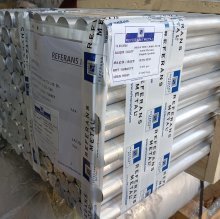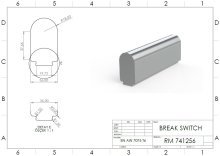



Листы/Плиты
Лист
Бар/Листовая Сталь
Трубы/Профили
1060
ASTM B209 / Al99.6 / 1060 / H18
| Chemical Properties | % Value |
| Silicon (Si) | 0,00 - 0,25 |
| Manganese (Mn) | 0,00 - 0,03 |
| Magnesium (Mg) | 0,00 - 0,03 |
| Copper (Cu) | 0,00 - 0,03 |
| Titanium (Ti) | 0,00 - 0,03 |
| Iron (Fe) | 0,00 - 0,35 |
| Zinc (Zn) | 0,00 - 0,05 |
| Aluminium (Al) | Balance |
| Physical Properties | Value |
| Density | 2.705 g/cm³ |
| Melting Point | 650 °C |
| Thermal Expansion | 21.8 µm/m.°C |
| Modulus of Elasticity | 68 GPa |
| Thermal Conductivity | 230 W/m.K |
| Electrical Resistivity | %62 IACS |
| Mechanical Properties | Value |
| Proof Strength | 110 MPa |
| Yield Strength | 130 MPa |
| Shear Strength | 75 MPa |
| Elongation A50 mm | %4 |
| Hardness | 68 HB |
The 1060 H18 aluminum alloy is known for its excellent machinability, good corrosion resistance, and lightweight nature. As a pure aluminum alloy, it is commonly used in applications requiring low strength. The H18 temper of the 1060 alloy offers a cold-worked, hardened material, which provides increased hardness and durability. This makes the alloy easy to process while offering properties such as electrical and thermal conductivity.
The 1060 H18 alloy is highly suitable for anodizing. Anodizing creates a protective oxide layer on the surface, which enhances the alloy’s corrosion resistance and provides an aesthetically pleasing finish. In terms of weldability, the 1060 H18 alloy generally performs well. As a relatively pure form of aluminum, it is easier to weld, and with proper welding techniques, strong and reliable welds can be achieved.
Regarding bending and forming, the 1060 H18 aluminum alloy is very machinable and easy to shape. Despite being cold-worked, it can still be bent successfully with the right processing methods. However, its use in high-vibration environments is limited. Due to its relatively low strength, it may not be suitable for applications requiring resistance to high stress and vibrations, but it works well for light, low-stress applications.
In terms of corrosion resistance, the 1060 H18 aluminum alloy is highly resistant to water, moisture, and atmospheric conditions due to its pure aluminum content. However, because of its low strength, it is not suitable for heavy-load applications. The advantages of 1060 H18 include excellent machinability, anodizing compatibility, and corrosion resistance, while its disadvantages include low strength and limited performance in high-vibration environments.
Choosing Factors for 1060 H18
- Strength: Moderate
- Machining: Poor
- Weldability: Very good
- Formability: Excellent
- Corrosion Resistance: Very good
- Heat Treating: Yes
Some Well-Known Applications for 1060 H18
It is used as a component of beverage cans in the food industry.
In billboard decorations,
Also on railroad tank cars.
- Plate

 Калькулятор Веса
Калькулятор Веса

